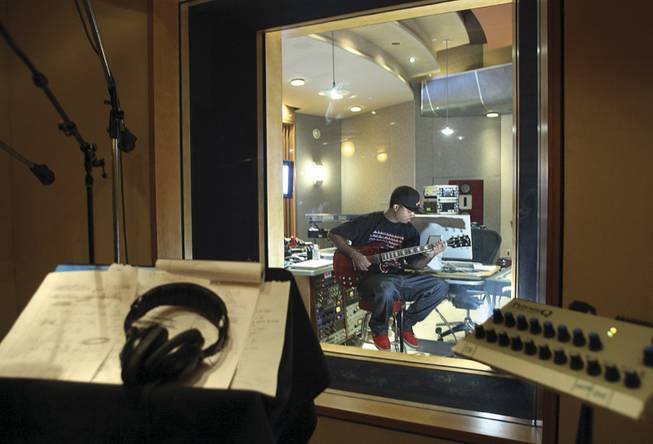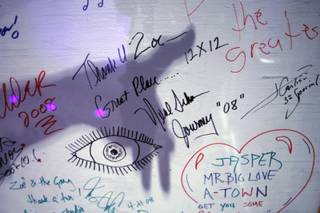
Jeremy “J” Stevenson, an engineer for Usher, takes a break in a control room at the Studio at the Palms, which has attracted some of the biggest stars in show business.
Wednesday, Feb. 4, 2009 | 2 a.m.
Sun Blogs
Beyond the Sun
Mary J. Blige - Growing Pains
It may be the most exclusive room in Las Vegas.
And it doesn’t matter if you’re a high roller, or if you’re holding, or even if you’re blindingly hot and hard-bodied.
Usher is in this club. So is Mary J Blige, the Killers and the cast of “Jersey Boys.”
Only one thing is going to admit you to this all-but-secret hot spot, and it’s not a black American Express card.
Talent alone (well, talent and money) will get you into the Studio at the Palms, the first and only multimillion-dollar recording studio inside a casino, discretely cloistered on an upper floor in the Fantasy Towers at the Palms. Arriving and leaving via secret entrances, big-name recording artists come here to play — not just play around (although they can if they want to).
A handful of recording studios have become legendary, even turning into pilgrimage destinations among the kind of music lovers who read liner notes: Sun Studio in Memphis and Abbey Road in London were the recording homes of Elvis Presley and the Beatles. Jimi Hendrix immortalized New York’s Electric Lady, Capitol Studios in Los Angeles were designed for acoustic perfection by guitarist Les Paul, and Fleetwood Mac made “Rumors” at the Record Plant in Sausalito, Calif. Some fans insist they can tell where a record was made just by the distinctive sound and feel of “the room.”
Palms owner George Maloof built the state-of-the-art studio (at the suggestion of Britney Spears’ manager, Larry Rudolph) with the intent of making Las Vegas a new music destination on par with New York, Los Angeles and Nashville, the preeminent music cities in the United States.
“It’s the first time a studio of this caliber has been built in Vegas,” says Studio director Zoe Thrall, who has worked as an engineer at New York’s Hit Factory and Power Station. “Which is quite surprising, when you consider there’s been 50, 60 years of entertainment here.”
The first client at the Studio at the Palms was blues guitarist Joe Bonamassa, who recorded on Dec. 6, 2005. The studio has since become a home away from home for a cross-section of musical artists, including hometown boys the Killers and Panic at the Disco, plus Spears, Death Cab for Cutie, Elton John, Guns N’ Roses, John Legend, Lang Lang, MGMT, the cast of “Jersey Boys” and new “American Idol” judge Kara DioGuardi.
And, um, Ali Lohan.
Two of the albums nominated for Sunday’s Grammy Awards were made at Studio at the Palms: Blige’s “Growing Pains” for Best Contemporary R&B Album, and Barry Manilow’s “In the Swing of Christmas” for Best Traditional Pop Vocal Album.
Thrall leads a tour through the elegant suite of rooms, an 8,000-square-foot expanse including Studio X and Studio Y, an airy “live room” with its blond wood floor and adjacent “isolation rooms” where, say, Mary J Blige might want to record an emotional vocal in private. At its heart is the control room, an oddly angled, technology-packed space where the artists can be seen and heard by producers and engineers, who are behind two panes of soundproof glass.
Suddenly a door opens and the hush is replaced by the bumping beats of the future: Usher is in one of the small rooms this morning, tweaking tracks that may make it onto his next album.
It almost goes without saying that the studio has the most up-to-the-moment technologies, but what makes it so attractive to many artists is the level of service provided here.
While many recording studios are on the outskirts of town or out in the country, making accommodations more expensive and luxuries difficult to attain, every imaginable amenity can be offered under one roof here, an only-in-Vegas bonus for artists and their entourages.
A typical day of recording for a top name artist can go up to 14 hours, Thrall says, noting that though the studio is typically booked by the day, the cost averages out to about $185 per hour to use the studio, not including an engineer’s fee.
“Really good engineers contribute so much to the sound of a record — it’s critical,” says Thrall, a New Yorker who cut her teeth as an engineer at Power Station. “It was that kind of place — one room would be Diana Ross, the next room would be the Rolling Stones, and the other room would be David Bowie.” Early in her career, E Street Band guitarist Steven Van Zandt took the fledgling engineer under his wing — Thrall toured with him as a sound engineer and even played on his first solo album as “a rock ’n’ roll oboist.”
Inspiration doesn’t stick to a 9-to-5 schedule, and Thrall and her crew — including a full-time audio tech — are on call 24 hours, catering to the needs and whims of their clients.
“There’s so much at stake for these artists, so much pressure and so much money involved,” says Thrall, who says protecting the musicians is one of the key elements of her job. “When an artist is making a record, they’re at their most exposed. The ideas have to come out and they have to be very relaxed for that creative process to work. You learn very quickly that you have to remain invisible, like ninjas.”
The requirements don’t extend to removing the brown M&Ms for fussy rock stars, but artists will often call on Thrall and her crew to redecorate and reconfigure the studio to make it more conducive to seeking their creative grail.
“When Celine was here we used tapestries to make the big room more intimate and cozy,” says Thrall, who besides having an awesome rock ’n’ roll name is the very soul of discretion about what goes on in her studio. She won’t talk about what she’s seen or heard in the studio, but will acknowledge that she was impressed by Dion, who would perform her show at the Colosseum at Caesars Palace, then come to the studio to record vocals for her album “Taking Chances.”
Remote rigs enable artists to record anywhere in the hotel, even their rooms, which might include the Palms’ 10,000-square-foot basketball-themed suite, which includes a half-court. And the unique proximity to the Pearl concert hall and the Rain and Moon nightclubs, which are networked into the studio’s control room, turns into another revenue stream for Maloof and the Palms. The Apple iTunes Store exclusively sells live recordings and live shows from the Pearl and the studio. The band My Morning Jacket recently released a six-song live recording from the studio (which somewhat makes up for the September concert it canceled in Vegas).
On Tuesday, the studio announced a USB technology called “Live in a Flash,” which can offer immediate live recordings of concerts, conferences and live DJ sets, ported to a USB flash drive.
Maloof calls it “the ultimate souvenir.”


Join the Discussion:
Check this out for a full explanation of our conversion to the LiveFyre commenting system and instructions on how to sign up for an account.
Full comments policy